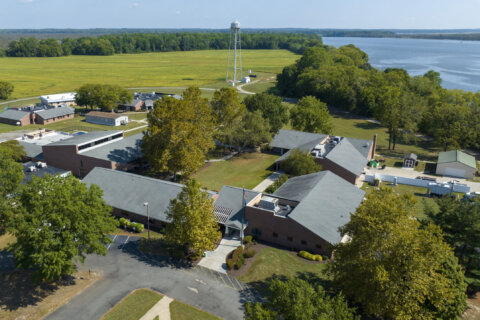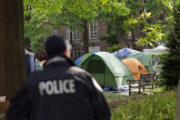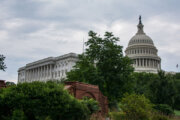This article was reprinted with permission from Virginia Mercury.
Virginia Tech developers and aviation leaders are working to bring automated and electric aircraft to Virginia in the future. But before the state dives into investments, it’s waiting on a study and the federal government to determine what it would need to do to get the new industry off the ground.
“Advanced air mobility has been on the minds of industry and some of the scientific minds like NASA and [the Federal Aviation Administration] for quite a while, and it’s getting to that point now where it’s becoming a reality,” said John Campbell Jr., one of the directors of the Virginia Department of Aviation.
What is advanced air mobility and why are officials interested in it?
Advanced air mobility is a term that refers to aircraft that are highly automated, more flexible than large commercial airplanes and usually electric. They include electric vertical takeoff and landing (eVTOL) aircraft, often referred to as air taxis. The concept has grown in popularity as a new way of offering travel and delivery services and reducing greenhouse gases.
The FAA has said such aircraft could help with transporting cargo and passengers, responding to emergencies and connecting to underserved and rural communities.
Because the technologies are new, regulations and infrastructure are still under development.
In June 2022, the U.S. joined countries including the United Kingdom, Canada, Australia and New Zealand to form the National Aviation Authorities Network, which is working to create certification criteria for the new forms of aircraft and plans for how to integrate them into the existing industry and airspace.
About a year later, the FAA released the Innovate28 plan outlining how these new air technologies can operate safely at one or more sites by 2028.
“This plan shows how all the pieces will come together allowing the industry to scale with safety as the north star,” said Deputy FAA Administrator Katie Thomson in a July 18 statement.
According to the Virginia Innovation Partnership Corporation, a nonprofit group that studies economic development in the commonwealth, the advanced air mobility industry could generate $16 billion in new business activity in the commonwealth.
Virginia Tech study
Last year, Virginia Tech’s Mid-Atlantic Aviation Partnership, which is one of seven FAA-designated test sites for unmanned aerial vehicles like drones, was asked to conduct a study that looks at the minimum infrastructure that would be needed for the industry to develop in Virginia.
The Virginia Advanced Air Mobility Alliance, a group made up of state officials and business, education and space industry leaders, is also participating.
“I think the state is being really smart in making sure that they don’t just throw money at this new term of ‘advanced air mobility’ that everybody’s excited about and instead, they’re looking at what can we do with our current airports that already exist,” said Tombo Jones, director of the Virginia Tech partnership.
The groups’ role is “to determine where they should spend money that stays within the state’s responsibility lanes, but also encourages public-private partnerships,” said Jones, who noted the study is expected to be completed at the start of the new year.
That study will highlight necessary infrastructure such as charging sites, radar services for tracking low-level aircraft and landing areas known as vertiports where self-driving or electric aircraft can land and take off.
“The report is going to have a number of recommendations to enable the type of infrastructure that would benefit drone operations today, that would benefit advanced air mobility operations tomorrow without getting ahead of the regulatory environment,” Jones said.
While he didn’t provide specific recommendations, he said it would outline how Virginia could invest in existing test sites and create pilot programs using existing physical infrastructure.
Investing in current testing locations could help attract aircraft manufacturers to Virginia, where they could conduct flight operations at test centers closer to the FAA’s Washington, D.C. office rather than traveling across the country.
Ongoing development
In the meantime, companies such as Virginia-based Boeing’s Aurora Flight Sciences and Vermont-based BETA Technologies have been developing and improving concept vehicles in Virginia and across the country.
Carmen Smith, a spokeswoman for Aurora, said airports and government agencies are increasingly expressing interest in electric and self-driving aircraft.
Aurora is working with Wisk, a subsidiary of Boeing, to design and certify a self-flying eVTOL air taxi.
“It’s an exciting time for the advancement of air travel,” Smith said in a statement. “It’s not only the operational and logistical advantages of solutions like air taxis, but also about electrification. We’ve seen the auto industry make strides in electrification, and most of the aircraft solutions in the advanced air mobility segment are also electric. An important part of revolutionizing air travel is providing a solution that is more sustainable.”
BETA has two all-electric aircraft, the net-zero ALIA conventional takeoff and landing and the ALIA VTOL, and is developing a charging network along the East Coast, with 17 fast-charging sites built and 55 more under development. In that endeavor, the company is partnering with the U.S. military, UPS and United Therapeutics, which delivers synthetic organs for human transplantation.
Campbell said some manufacturers have committed to completing their concepts by 2024-25, but they may have to wait on the FAA to certify them.
Virginia also has other efforts underway to prepare for the new technology. In November, it joined seven other states at the Advanced Air Mobility Multistate Collaborative in Northern Virginia to discuss ways to grow the industry, Virginia Business reported.
Campbell said experts have been exchanging information through the Virginia Flight Information program for much longer. He said rather than having 3,000 localities across the country create their own rules and regulations on how to fly new types of aircraft, it is wiser to talk with other states to work through some of the issues.
“While the FAA controls the airspace, we’ve got issues on the ground that need to be taken care of,” Campbell said. “We are working with local planners and community developers on infrastructure needs, such as electrical power, as well as zoning regulations to help get communities ready. We wanted to get that conversation started so we’re not caught behind the eight ball when that first eVTOL takes off.







